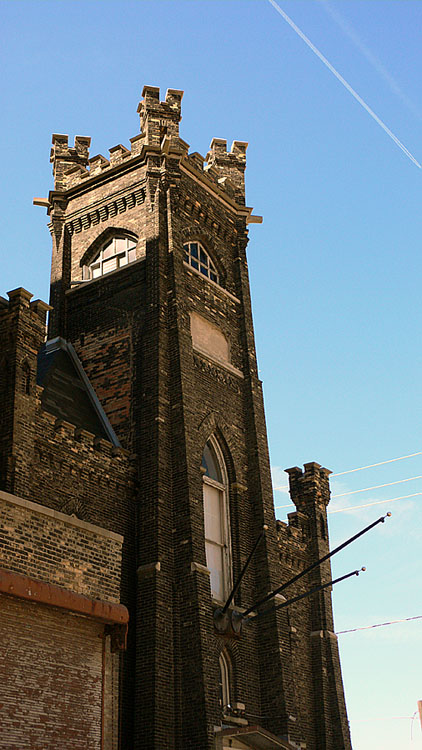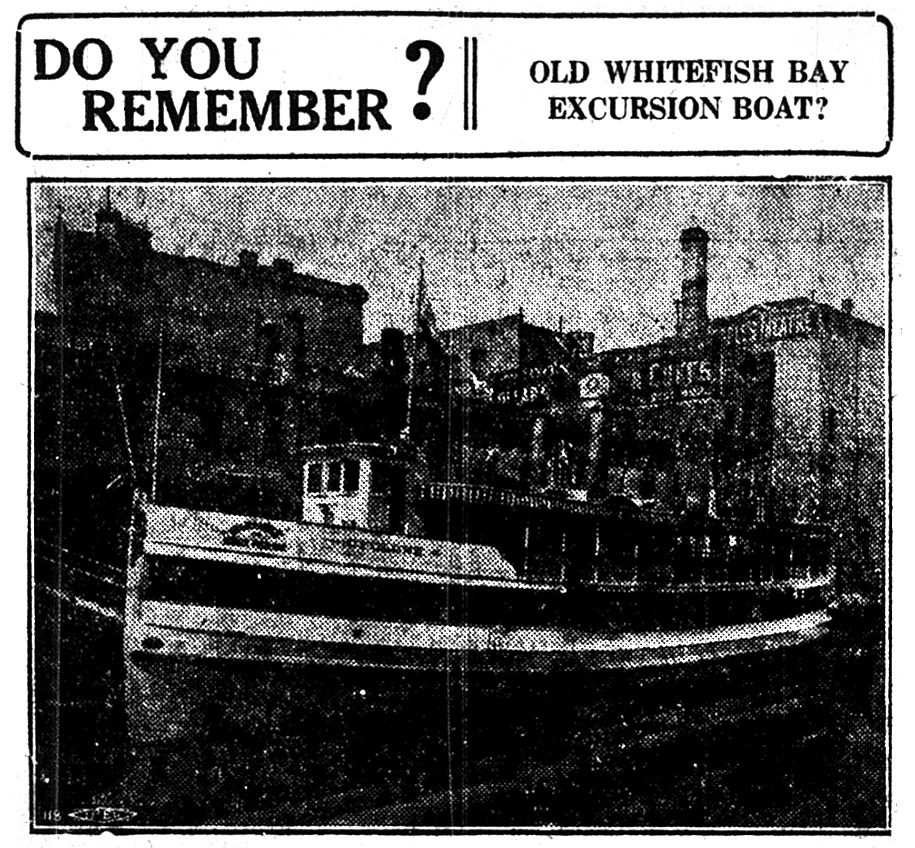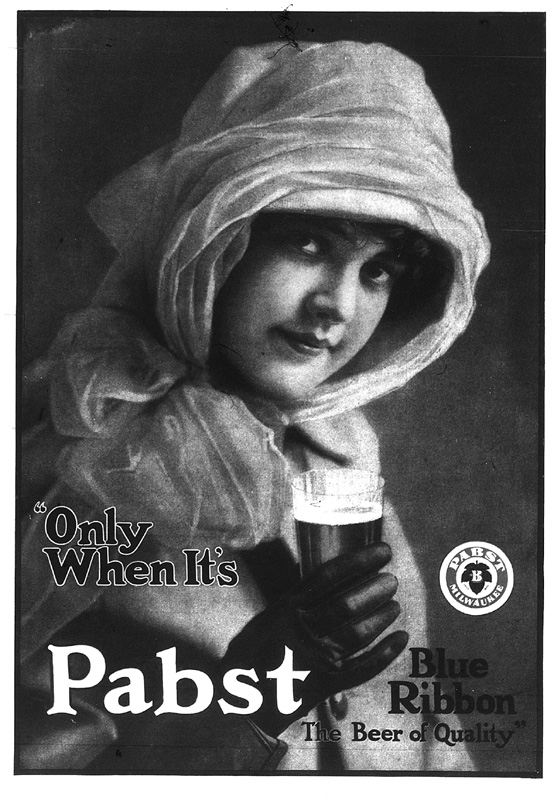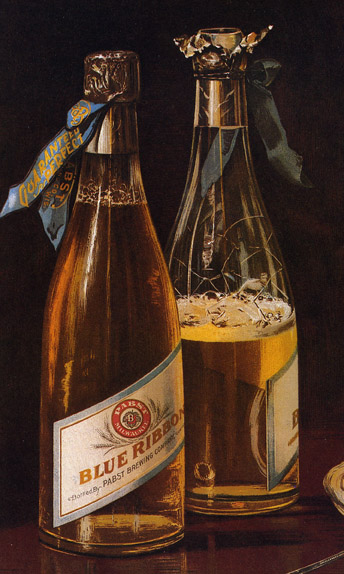Looking east on Florida Street from 6th Street sometime in the early 1950s.
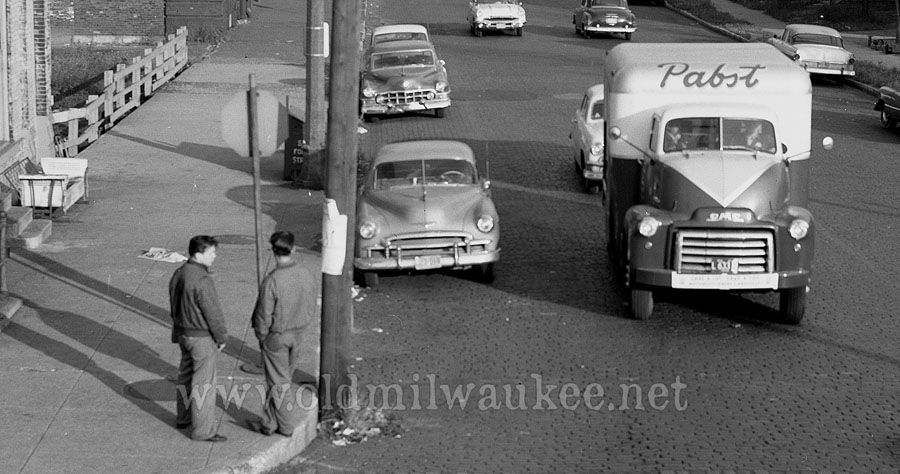
The big news unveiled today was the announcement that Pabst will once again be brewed in Milwaukee. The location of this new microbrewery and tasting room is the former Forst-Keller in the Pabst brewing complex. Several newspaper articles over the years tell of its long history including this one from 1953.
This 1973 article tells of the final closing of the restaurant.
Milwaukee Journal, September 2, 1973
Landmark Cafe to Close
The Forst-Keller, a German restaurant at 1037 W. Juneau Ave. and an official Milwaukee landmark, will close Sept. 15.
The Pabst Brewing Co., which has since owned the restaurant since the late 1890s, plans to turn the building into a brewery museum. The restaurant, originally a German Methodist Church, was built 100 years ago. In July it was designated an official landmark by the Milwaukee Landmarks commission.
The restaurant has had a long and colorful history. Over the years it has been a meeting hall for three singing societies – the Milwaukee Liederkranz, the Lieder Tafel, and the Bel Canto Chorus. The restaurant has also been a popular eating place for Courthouse judges and employes and for brewery workers.
The Forst-Keller closed for six months in 1971. It was reopened in December of that year and has been operated ever since by Karl Skacel and his wife, Gretchen. The Skacels formerly operated Karl and Gretchen’s Supper Club on Lake Nagawicka.
The restaurant was operated from 1937 to 1960 by two brothers, Richard and Fritz Baumann. Their wives did all the cooking.
Between 1964 and 1971 Adolf (Adi) Binder ran the restaurant. Binder’s mother, known as “Mutti” to customers, was the chief cook.
During World War II the Forst-Keller and other German style restaurants in the city were believed to be gathering spots for Nazi supporters. It was said that FBI agents began frequenting the restaurant in the line of duty during the war years.
No date has been set for its reopening as a museum. A brewery official said the company would refurbish the building. It will house Pabst’s collection of old beer steins, antique brewing equipment and other mementos.
And finally this newspaper story from 1901 sheds a more humorous light on the history of the Forst-Keller. Hope to have a beer there with you when it opens!
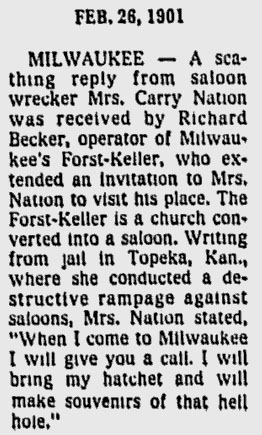
Local writer and historian Carl Swanson wrote a history of the Whitefish Bay resort on his blog. It brought to mind this article written by Frederic Heath back in 1920 about the excursion boats that serviced the resort from downtown. Heath’s article fills in some of the details of the resort.
Milwaukee Leader, April 13, 1920
By Frederic Heath
Whitefish Bay as a resort for city-baked people seeking the cooling influence of lake, woods and grass in the good old summer time, is now merely a memory. The old steamboat pier is almost washed away, just as the old piers off Huron and other early streets also disappeared.
Afternoon and night crowds flocked to the resort north of the city and from the high terrace viewed old Michigan by day, or hunted pebbles on the beach below, and at night sat at the open air tables, drank their beer, munched their caviar sandwiches, and chatted or watched the lights on steamers and schooners passing to and fro on the black waters out in the lake.
Excursions Years Ago.
It is the criticism of strangers coming to Milwaukee that our people act as though the lake were merely to be tolerated, and they wondered why excursions on the bay and to near-by points are not a part of the city’s enjoyments. This criticism would not have held good years back, for there was a Whitefish Bay boat making regular trips that was well patronized. It was 25 cents a round trip and there was always a comfortable crowd on board when the weather was at all favorable.
The view given today is of the Cyclone, one of the steamers that successively handled the bay excursion business. It had its dock just north of Grand Ave. bridge, alongside the old No. 2 Grand ave., which was for many years the old Pollworth Home restaurant. The river at this point could tell many historical facts, had it the power of speech. For years and years Old Abe Muehlendyke rented rowboats at the lakeshore, off the present Juneau park. But the memory of man goes back a little further to the days when Abe’s boat livery was originally situated on the shore of the river, also near the Grand Ave. (Spring St.) bridge.
Park System Blamed.It is altogether likely that the passing of Whitefish Bay can be laid to the door of the development of the city park system. Lake park, with its cool shades, its beautiful view of the lake, its accessibility and its band concerts and other attractions, became a powerful competitor to Whitefish Bay before motor vehicles became common, and even afterward they do not appear to have put the bay back into favor, as might have been expected.
Whitefish Bay is getting nearer and nearer to town. A few years ago the county was offered, free of charge, a strip along the lake shore in Whitefish Bay village, just north of the turn on to the county loop (Silver Spring Rd.) for park purposes, but there were enough wise ones in the county board to block its acceptance. It was a narrow strip and the edge of the bluff was close to a Whitefish Bay street, which would have to be protected from landslides at some cost, but even so, a par at that point would have given the people access to the lake. Now the Whitefish Bay resort is gone and the public cannot reach the beach without becoming trespassers. All of which is sincerely to be regretted.
In the early 20th century advertisers tried to make Pabst seem as glamorous as possible by using beautiful women gently hoisting a stein. It’s a long way from current ad campaigns branding it as the beer for tattooed hipsters. What makes it interesting is that this is about the time when Prohibitionists were out in force working on the demise of all alcohol. The brewery industry needed to portray a gentle, upper-class view of beer to offset the base degradation usually painted by the Prohibitionists.
From the Milwaukee Sentinel, January 1, 1914.
Breweries were always well known for the purity of their product and all the Milwaukee breweries originally used artesian wells to tap into a very clean source of water to brew beer. Of course those wells don’t last forever especially when the well is used heavily. The Pabst brewery well lasted until 1902 when it was forced to use city water drawn from the lake. This article tells about that problem and a little bit of the history of that spring.
Milwaukee Journal – June 12, 1902
WELL RUNS DRYPABST BREWERY ASKS FOR WATER FROM THE CITY.
Famous Springs Which Had a Reputation in the Days of the Indians Appear to Have Yielded All Their Resources to the Making of Beer and Another Supply is Needed.
The artesian wells which have for many years supplied the water for the famous products of the Pabst Brewery have failed and the company has petitioned the city authorities for water accommodations and will be supplied with a large main, which will be laid from Third and Prairie streets.
The springs at the brewery were famous long before the site was selected for the largest brewery in the world and the water which gushed from the earth there was known among the Indians as the great “Mankaki waters” at a time when the great northwest was a wilderness. The springs were enlarged by Jacob Best, founder of the brewery, and later the artesian wells were sunk as the flow from the springs was not sufficient to supply the greatly increased needs of the brewery. For nearly a score of years this water has been used to make the body of the Pabst beer and its purity and wholesomeness have been a great boon to the company. About one year ago the supply began to fail and it has been a great source of worry to the company, and at present a large quantity of city water is being used. Last month alone more than $5,000 worth of water was purchased from the city mains and as soon as the big 15-inch pipe which the city engineer will ask to be laid is tapped, the company will probably become the largest user of municipal water.
